

Sudanese teddy bear blasphemy case. Arrest[edit] Gillian Gibbons was born in 1953 and gained a Bachelor of Education degree from the CF Mott College of Education in Prescot in 1975 (the college closed in 1992).

Teaching in a school in Sudan, she was arrested for allegedly insulting Islam by allowing her class of six-year-olds to name a teddy bear "Muhammad".[1][2][3] Sudan's legal system is strongly influenced by sharia, which prohibits depictions of Muhammad and other prophets.[1] However, many Muslim organizations in other countries publicly condemned the Sudanese over their reactions,[5] as Gibbons did not set out to cause offence.[6] The chairman of the Unity School council, Ezikiel Kondo, indicated that he perceived ulterior motives in the affair, "The thing may be very simple, but they just may make it bigger. It's a kind of blackmail. Conviction and reaction[edit] Release[edit] Afterwards[edit] The school was closed until January 2008 for the safety of pupils and staff as reprisals were feared.[3][22] Enluminures en Islam.
Même si elle ne fait pas l’objet d’un interdit explicite dans le Coran, l’image figurative est, dès l’origine de l’islam, totalement exclue du domaine religieux.
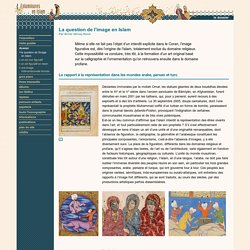
Cette impossibilité va conduire, très tôt, à la formation d’un art original basé sur la calligraphie et l'ornementation qu’on retrouvera ensuite dans le domaine profane. L'islam interdit-il les images de Mahomet? Cet article a été initialement publié en 2011.
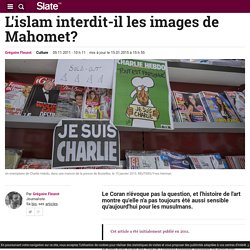
Le sujet avait éclaté aux yeux de l’opinion publique mondiale en 2006 avec l’affaire des caricatures de Mahomet parues dans un journal danois, celui de la représentation du prophète musulman. Représentation de Mahomet : "L'islam a perdu de vue sa propre histoire" Conservateur du patrimoine, Sophie Makariou a rejoint les équipes du Musée du Louvre en 1994.

Elle a été nommée à la tête du département des Arts de l’Islam créé en 2003 et dont les nouveaux espaces ont été inaugurés en 2012. François Bœspflug, Caricaturer Dieu ? Pouvoirs et dangers de l’image. 1Dominicain et professeur d’histoire des religions à la faculté de théologie de Strasbourg, François Bœspflug livre une synthèse très bien faite et documentée des débats internes aux grandes religions sur la question des images en général, et de l’image de Dieu en particulier.
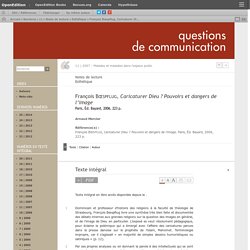
Mohammed Image Archive. Mohammed Image Archive (return to main Archive page) Islamic Depictions of Mohammed in Full Medieval Muslim artists often created paintings and illuminated manuscripts depicting Mohammed in full.
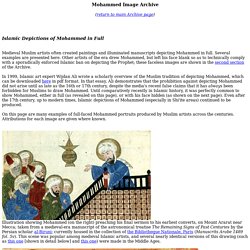
Several examples are presented here. Other artists of the era drew Mohammed, but left his face blank so as to technically comply with a sporadically enforced Islamic ban on depicting the Prophet; these faceless images are shown in the second section of the Archive. L'émir, l'image, l'Islam. Does Islam ban images of Mohammad? Outrage over a series of Danish cartoons that depict the Prophet Mohammed continues to spread throughout the Muslim world.
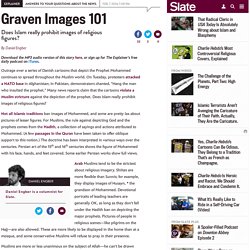
On Tuesday, protesters attacked a NATO base in Afghanistan; in Pakistan, demonstrators chanted, "Hang the man who insulted the prophet. " Many news reports claim that the cartoons violate a Muslim stricture against the depiction of the prophet. Does Islam really prohibit images of religious figures? Not all Islamic traditions ban images of Mohammed, and some are pretty lax about pictures of lesser figures. For Muslims, the rule against depicting God and the prophets comes from the Hadith, a collection of sayings and actions attributed to Mohammed. Daniel Engber is a columnist for Slate. Arab Muslims tend to be the strictest about religious imagery. Muslims are more or less unanimous on the subject of Allah—he can't be drawn under any circumstances. Christian attitudes vary widely.
Depictions of Muhammad in Islamic Art. 15th-century manuscript illustration of Muhammad (not shown) preaching to followers.

Persian illustration from 1320 of Bahrum Gur, hero of the Shah-nameh, killing a dragon. (Cleveland Museum of Art) "Thou shalt not make unto thee any graven image, or any likeness of any thing that is in Heaven above, or that is in the earth beneath, or that is in the water under the earth. You shall not bow down to them or serve them; for I the LORD your God am a jealous God. " -- Second Commandment (Exodus 20:4-5) "Those who paint pictures would be punished on the Day of Resurrection and it would be said to them: Breathe soul into what you have created. " Q&A: Depicting the Prophet Muhammad. Protests have spread across the Muslim world over the publication in Europe of cartoons of the Prophet Muhammad.
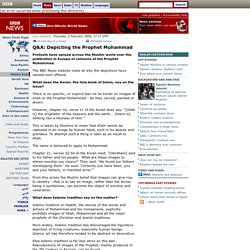
The BBC News website looks at why the depictions have caused such offence. What does the Koran, the holy book of Islam, say on the issue? There is no specific, or explicit ban int he Koran on images of Allah or the Prophet Muhammad - be they carved, painted or drawn. However, chapter 42, verse 11 of the Koran does say: "[Allah is] the originator of the heavens and the earth... In Art Museums, Portraits Illuminate A Religious Taboo. All depictions of Muhammad -- or so we hear daily -- are now and have always been forbidden in Islam.
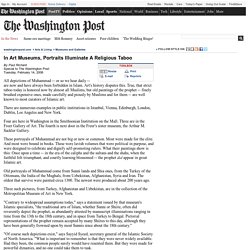
Art's history disputes this. True, that strict taboo today is honored now by almost all Muslims, but old paintings of the prophet -- finely brushed expensive ones, made carefully and piously by Muslims and for them -- are well known to most curators of Islamic art. There are numerous examples in public institutions in Istanbul, Vienna, Edinburgh, London, Dublin, Los Angeles and New York. Four are here in Washington in the Smithsonian Institution on the Mall.
Three are in the Freer Gallery of Art.